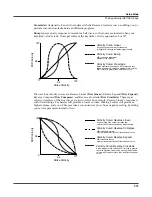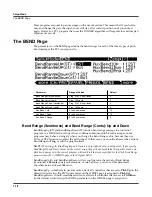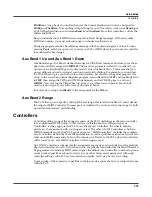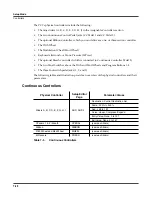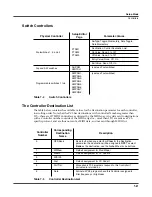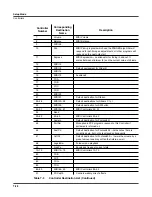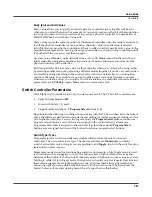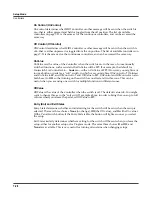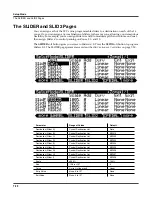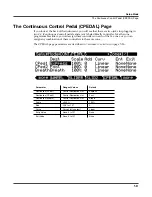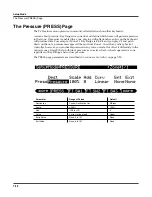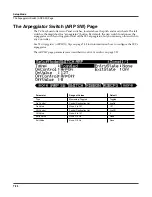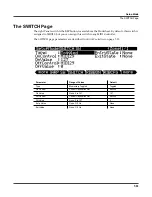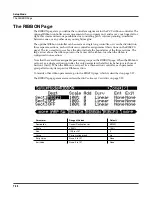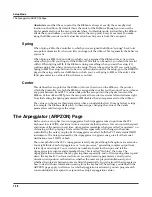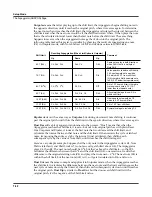
Setup Mode
Controllers
7-27
Entry (Ent) and Exit Values
Entry value allows you to specify an initial value for a controller in a setup that will be sent
whenever you select that setup. For example, if you want to make sure that all of the modulation
in a zone is turned off when you select a setup, assign a physical controller to a destination of
MIDI 01 (MWheel) and set Entry Value to
0
.
Entry values ignore the current position of the physical controller when the setup is selected. In
fact, if the physical controller is above or below the entry value when the setup is selected
(which it often is), moving the controller will have no effect until it is past its entry value. In the
modulation example above, moving the assigned controller won’t turn on any modulation until
it’s pushed all the way
down,
and then up again.
An entry value of
None
is quite different from a value of
0
.
None
means that there will be no
initial controller command when the setup is selected, and any subsequent movement of the
physical controller will be effective.
Exit Value tells the PC3 to send a value for that controller whenever you leave the setup, either
by selecting another setup or by selecting a different mode altogether. It can be very useful when
a controller is doing something to the sound, and you don’t want that effect to continue after
you leave the setup. For example, if you want to make sure a zone’s pitch returns to normal
whenever you leave a setup, you would set Exit Value to
64
for any controller whose Destination
parameter is set to
PitchUp
. Again,
None
means no command is sent.
Switch Controller Parameters
Switch (physical) controllers have only two states: on and off. The PC3 switch controllers are:
•
Panel Switches
Arp
and
SW
•
Footswitch Pedals 1, 2, and 3
•
Programmable Switches 1–8 (
Program Select
buttons
1–8
)
Keep in mind the following two things when working with the PC3’s switches. First, the buttons
above the sliders are dedicated to zone status and muting, as well as sequencer muting, and are
not
assignable controllers. Second, in Program mode, the
Program Select
buttons function as
program select buttons if none of them are assigned in the control setup; if at least one
Programmable Switch is assigned in the control setup, then the assigned
Program Select
buttons act as assigned, but none of the buttons function as program select buttons.
Switch Type (Type)
The parameters for switch controllers are slightly different from those for continuous
controllers. The first parameter is Type. The choices available are
Momentary
in which a
switch’s action lasts only as long as you are pushing it, and
Toggle
, in which the switch’s action
lasts until you press it again.
Momentary mode is used for functions like sustain or portamento, while Toggle mode is used
for functions such as arpeggiator on/off. The buttons show which mode they are in by the
behavior of their lights: if a button is in Momentary mode, its light glows only as long as you are
holding it, while if it is in Toggle mode, the light stays on until you press it again. Bear in mind
that button assignments are independent per zone, and since there’s just a single light per
button, the light shows the state of the button only for the current zone. When you press the
button, however, it executes its assignments for all zones that use that button.
Содержание PC3
Страница 24: ...1 6 Introduction Options ...
Страница 50: ...4 4 The Operating Modes Using the Modes ...
Страница 174: ...7 54 Setup Mode The Utility Soft Buttons ...
Страница 178: ...8 4 Quick Access Mode Making Your Own QA Banks ...
Страница 204: ...9 26 Effects Mono Algorithms ...
Страница 266: ...A 2 MIDI Implementation Chart ...
Страница 308: ...Index x ...



